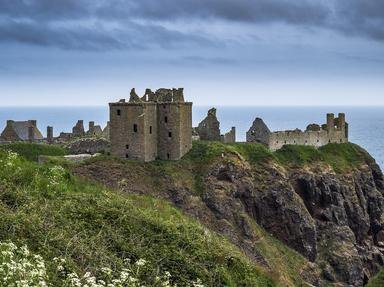Quiz Answer Key and Fun Facts
1. As we travel west along the Solway Firth, away from Gretna Green, we pass the Mull of Galloway, the most southerly point of Scotland. Here, we begin to travel north. Out in the Firth of Clyde is a small volcanic island. What is it called?
2. We travel up the Firth of Clyde, and we come to a town that was a Royal burgh from 1205 until 1975. Just to the north is one of Glasgow's two airports, and the town looks out across to the Isle of Arran. Where are we?
3. The Firth of Clyde, eventually turns into the River Clyde and heads towards Glasgow. This part of Scotland is synonymous with a particular industry. Which one?
4. Much of the western, Atlantic, coast of Scotland is rugged and sparsely populated. Off this coast are many islands including Jura, Islay and Mull where some of the best single malt whisky is produced. Our destination, however is even further north, and farther out into the Atlantic Ocean. We are in the Western Isles. What is the other name for this group of islands?
5. On the very far north coast of Scotland we pass the most north westerly point of Britain at Cape Wrath and continue heading east. Just before the town of Thurso, which is the northernmost town on the mainland, we arrive at the home of a nuclear research establishment. Which of the listed facilities is it?
6. Just across the Pentland Firth from Thurso and John O'Groats, are the Orkney Islands. This is a small group of islands, and contains a 137m tall sea stack called The Old Man of Hoy. It is also the location of a famous natural anchorage that has been is use for over 1000 years. What is the name of this stretch of water?
7. We enter the Moray Firth, which is the largest firth in Scotland. At the far end lies a city which gives us access to the northern end of Loch Ness. It was near to this city that the Battle of Culloden took place in 1746 during the Jacobite Rising of 1745/6. What is the name of this city?
8. We leave the Moray Firth and for a short time head east, at the town of Fraserburgh we turn the corner and begin to go south. We pass the easternmost town in mainland Scotland, Peterhead, and the early 19th century lighthouse at Buchan Ness. We arrive at our destination, which is Scotland's third largest city. Where have we landed?
9. As we continue to travel south from the easternmost town in mainland Scotland, Peterhead, we cross the Tay Firth, site of a famous railway disaster close to Dundee in 1879, when a bridge collapsed, with the loss of 75 lives. The famous golf course of St Andrews is also on this coast. We finally arrive at the last major city on the east coast of Scotland, Perth.
10. We have completed our trip around the coastline of Britain, which has taken us on a journey of around 12,000km. We have re-entered England at the town of Berwick-on-Tweed, a town which has changed hands between England and Scotland on numerous occasions. Not far to the south, and just off the coast, lies a small island, one of several with the name of Holy Island. This one gave its name to a folk group that started in 1969, and was still recording in the early part of the 21st century. What is the name of this island?
Source: Author
romeomikegolf
This quiz was reviewed by FunTrivia editor
gtho4 before going online.
Any errors found in FunTrivia content are routinely corrected through our feedback system.

